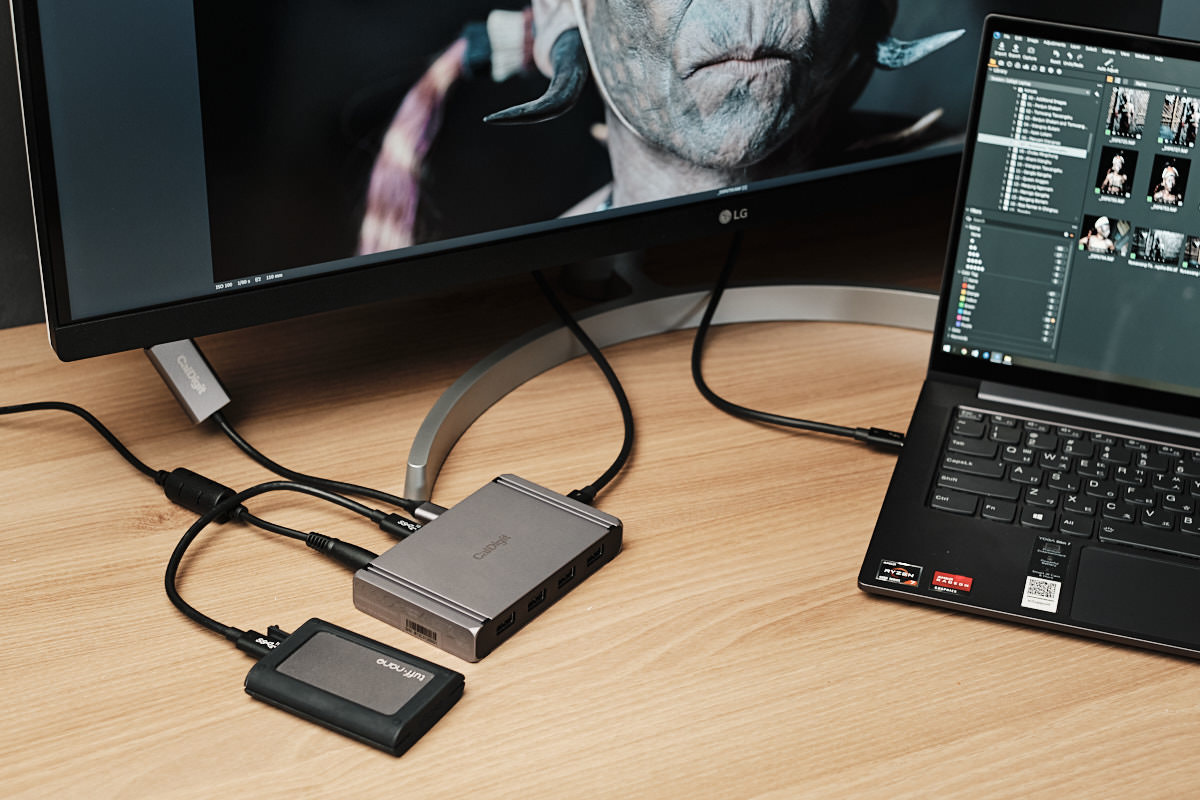The number of devices we need to connect to our computers on a daily basis seems to be never-ending. From SSDs to monitors and graphics tablets, it seems like we never have enough ports. The CalDigit Thunderbolt 4 Element Hub attempts to address this by simply giving us a large number of our most commonly used ports, USB and Thunderbolt, and making sure they all operate at full speed.
What Is the Element Hub?
Caldigit has made several full-featured docks over the years, but the Element differs from those in the sense that it is a much more straightforward device. You get seven USB ports. Three of those are USB 4/Thunderbolt and four are USB Type-A Gen 3.2 ports. Considering how much those Type-C/Thunderbolt ports are capable of, the hub comes with a power adapter to ensure that no matter how much you plug in, everything will still operate to its full capacity. As the name suggests, this is a no-frills hub that offers excellent expandability for desktop and laptop users.
USB 4/Thunderbolt
The three Type-C/Thunderbolt ports are of the full-featured variety. No functionality has been left out, and they do not limit each other. Thus, if you want to run an 8K monitor and a few SSDs copying data at full rate, you can. The same thing goes for dual 4K 60Hz monitors. For on-location work, where you may need to connect several monitors and back up a large amount of data, this might just be the perfect solution.
Being that I’m an editorial and family photographer, I haven’t had a lot of need to invest in an 8K monitor or even dual 4K monitors. However, I was able to test a single 4K monitor running over a Type-C to HDMI connector alongside a USB-C DP Alt monitor from Asus. While playing back 4K video, running Capture One, and making a huge file copy across a pair of SSDs on my Lenovo Yoga Slim 7 (Ryzen 7), everything ran smoothly and uninterrupted.

Limitations
Of course, there are certain devices that don’t play nicely with hubs. I’ve found that my Wacom tablet and Loupedeck+ didn’t want to connect at all through this (or any hub, for that matter), so you’ll likely still need other ports/connectors for devices like these. Of course, that’s not a reflection on this hub, but a limitation of the devices. Of course, your mileage may vary on what does and doesn't play nicely with your configuration.
As photographers, we’ll often need a card reader, and I would definitely consider this to be one of the basic elements of my workflow. That is maybe the one thing I wish had been included. However, it is quick and easy to connect a card reader for the type of cards you use, and my StarTech Dual SD UHS-II reader has been working flawlessly through the Element Hub.

Compatibility
The Element Hub requires a minimum of a basic USB-C port to get connected, but certain features like multiple monitors and extremely fast transfers will benefit from, or in some cases, require a Thunderbolt 3 and up or USB 4 enabled port.
In terms of operating systems, Mac OS 11, Windows 10, or iOS 13.6 are supported. So, a Windows laptop or tablet, Apple computer, or iPad will all work flawlessly. As a curiosity, I did try to get Samsung Dex running, but was unable to get it to display to external monitors. File transfers worked fine, however.
Who Is It For?
I can see it being useful on set when multiple devices need to be connected to, for example, a laptop or tablet. It is quick and easy to connect multiple monitors and fast SSDs to ensure a shoot goes off without a hitch. Especially for those using USB 4 or Thunderbolt-enabled workflows, there are a plethora of connection options opened up by this tiny device.
For my needs, this hub is likely overkill. But, it has been extremely useful to have all the ports I need operating to their full potential without having to worry about what is connected. I primarily work from a desktop machine, so the biggest benefits for my workflow have been not having to reach behind the machine and find the Type-C port as well as having multiple Type-C ports for my ever-growing collection of devices.

In Conclusion
If you’re in the market for a hub with no frills that just offers the best performance our current ports are capable of, this is a solid option. Check out the full specs and pick one up here.
Things I Liked
- Speed
- Number of ports
- Powered to allow for all ports to be used simultaneously
- Size
Things I Felt Could Be Improved
- Including a card reader







It would be even better if it were reliable. My first one failed completely after 6 mo.; 2nd 0ne has 2 ports that failed after 30days. Caldigit makes it extremely difficult to return a unit but it makes a good paper weight.
That is interesting to hear since I flirted with the idea to buy one.
I am also thinking about a 2nd TS3+ for my 2nd computer. The first one worked great for me - I had to return it once but the replacement is very reliable.
Maybe it is a TS3+ again. 🧐
Amazon
Currently unavailable.
We don't know when or if this item will be back in stock.
My Wacom pro tablet works well with a cheap standard usb hub!
CalDigit SOHO have a card reader
Using for a while, no regrets so far